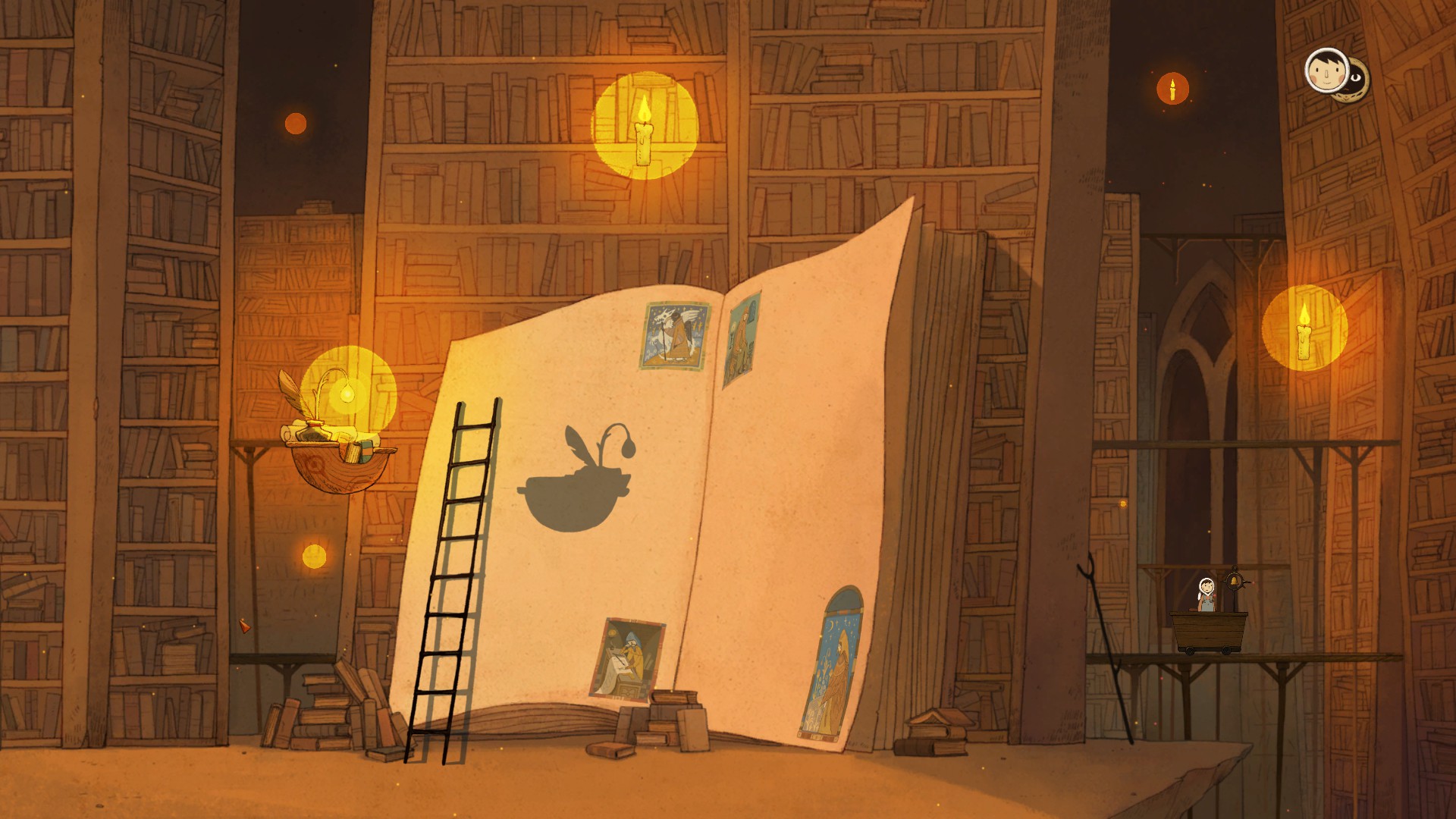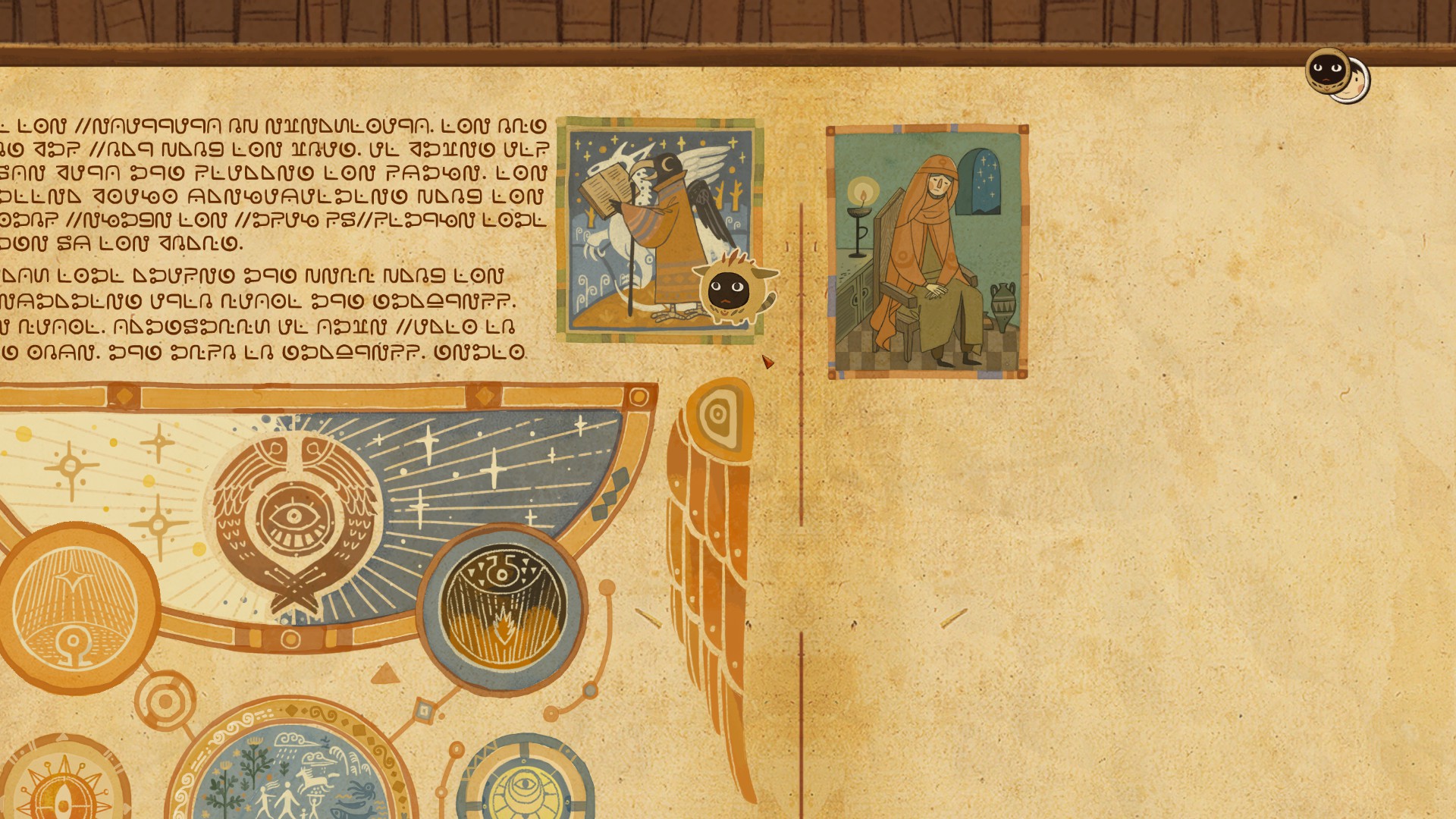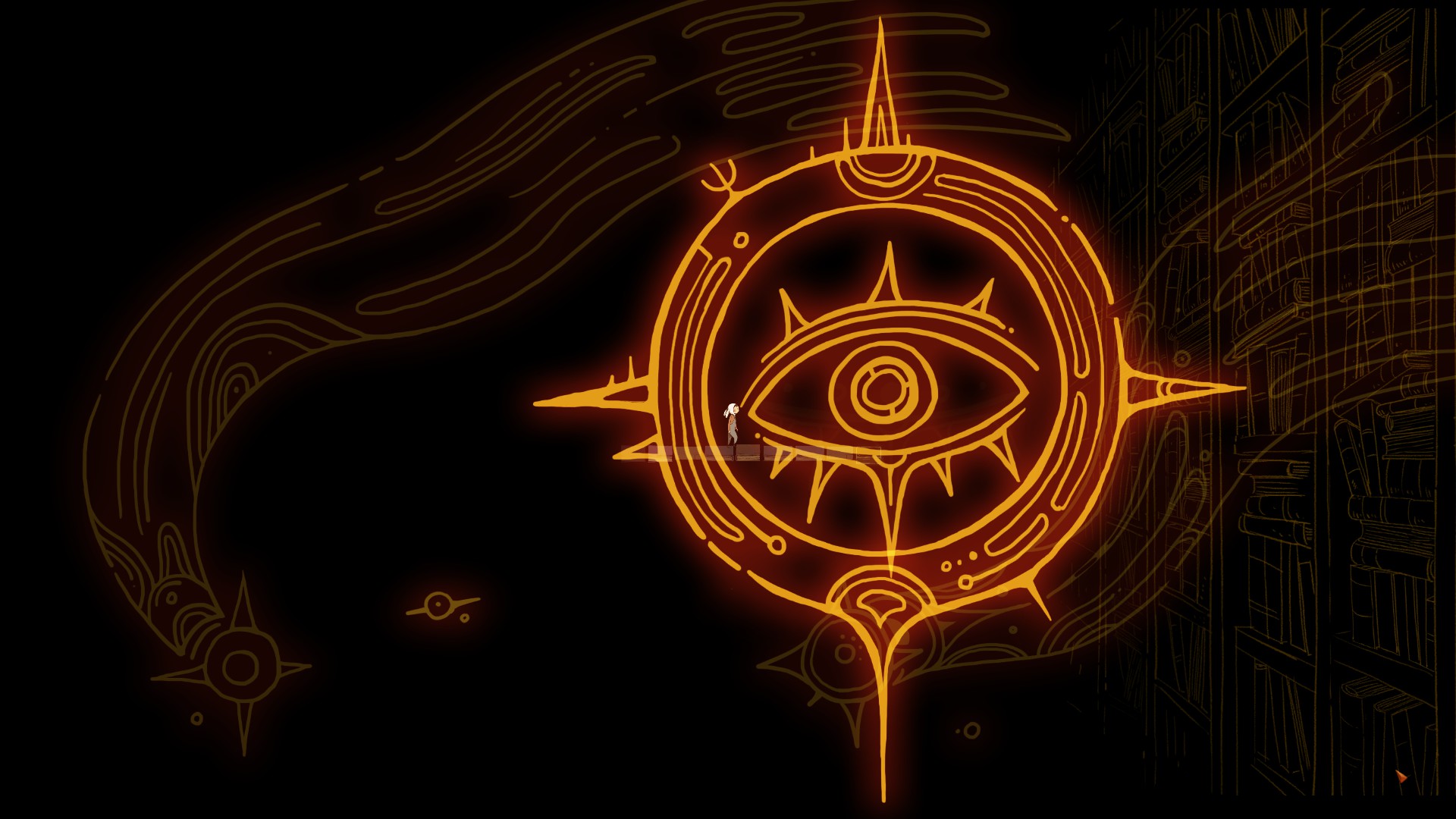This is a guest post by Alvina Lai. Alvina holds an MS in Library and Information Science from Pratt Institute, and a BFA in Photography and BA in Creative Writing from The New School. Their writing appears in The Mary Sue, Brooklyn Botanic Garden, and the NYT’s “Metropolitan Diary”; all of which can be found on their LinkedIn.
The boy and his companion, Layh, have just climbed fifteen floors up the abandoned magical tower. They had earlier encountered magical shadows, moving paintings, moon mice, ethereal beings, and a room that changes seasons with the hit of a button. By the time they reach the library, they, and we, are familiar with the mysterious and mystical. We are not surprised by the floating candles, endless bookshelves, and giant tome before us.
This article compares LUNA‘s in-game library to real-world libraries and examines the influences of real-world library design in the game. I also discuss the puzzle and how it turns the player and characters into various library roles and librarian models, such as patron, reference desk librarian, and roaming librarian. Finally, I discuss the trope of the magical library, and how this trope allows audiences to appreciate the library as a place of mystery, as well as place of knowledge.
The Game
LUNA The Shadow Dust is a point-and-click adventure about a boy and an animal named Layh, two playable characters, who go on a quest to restore light and balance to a magical world. The boy and Layh have to journey up an abandoned tower to find a powerful shadow and reverse the damage from a magical incident in the past. The game was developed by a small international team, and draws inspirations from Studio Ghibli, Ursula K. Le Guin’s Earthsea novels, artist Shaun Tan, as well as historical images. The game doesn’t have real-world text or dialogue. Music, art, and wordless interactive puzzles drive the story forward.
At the beginning, the player sees a muted wall painting that tells the lore of the in-game world. As the boy, who stands by the wall, walks from one part of the wall painting to another, the painting lights up. According to a YouTube video by the developers, Lantern Studio, symbols and illustrations on the wall (and throughout the game) were inspired by art in Ancient Egypt, Ancient India, as well as by Chinese dugong cave paintings and Aztec sculpture. By establishing history and magic as key features (or clues), players know to look for ways to engage with these concepts throughout the game. This is especially true in the library level.
Level 15: The Library
Later in the game, the boy and Layh arrive in the library and are dwarfed by the packed, looming bookshelves and a giant, blank tome. The tome is so big, rested open, it has its own ladder to reach the top of the page. Scattered in the air are floating candles, reminiscent of the dining hall scene in Hogwarts. The room is so big, that there’s a mine cart rail system to get around. Near the blank tome is a floating desk with a light. The floating desk’s shadow is cast onto the giant tome. The boy and Layh have become library visitors, or patrons. Or, perhaps, they (and the player) are actually the librarian(s).
How similar is LUNA’s library to a real-world library? The most notable feature of the library are its bookshelves. Shannon Mattern provides a brief history of the bookcase that explains possible inspirations for the design. Since the days of Mesopotamia, scrolls and codices have been stored away. As humanity arrived in the Middle Ages, institutional libraries rose in popularity. Books were displayed openly and horizontally. To avoid theft, monastic and university libraries chained books to the library itself. This took up a lot of space, so books were turned upright and unchained.
As bookshelf design came closer to modern day, new technologies allowed for compact display, and even digital books that eliminated the need for bookshelves all together. However, “The aesthetics of the old-fashioned, public-facing stack still seem to be in fashion,” says Mattern. She provides examples of modern libraries using the old-fashioned style of public-facing stacks. Even if modern libraries are made of glass and metal, or use “robot librarians,” the visibility of countless books is still valued. The choice to have a physical library, instead of a digital one, is intentional. Mattern states, “The epistemological implications of this aesthetic might seem obvious: these architectural projects put on display, and make empirical, if not always navigable, the wealth of knowledge that their collections represent.”
LUNA’s looming bookshelves pay tribute to this narrative. Players can see a gothic window in the distant background (much like a monastic library), books collapsed upon each other in the dusty “stacks” (a storage area, opposed to a reading area like a reading room), and the (floating) desk with a quill pen and candle. The never-ending bookshelves are a simple way to show that magic, mystery, and knowledge are key to the gameplay and storytelling. While it may not be common to find giant bookshelves or quill pens in the local public library, LUNA’s bookshelves draw from true historical design in real-world libraries.

What about the rail system? In LUNA, the boy rides the mine cart, zips around the library, and returns with a handful of floating books. While the mine cart seems whimsical, it can be seen as a historical analogue to more recent transportation technologies used in real-world libraries. For example, New York Public Library’s Schwarzman Building did use a pneumatic tube system in the 1900s. It sent and retrieved catalog requests from the stacks through tubes that were installed throughout the library. In 2016, the same NYPL building installed a conveyor system that “consists of 24 individual red cars that run on rails.”
In addition, the vast size of LUNA’s library is accurate to some real-world libraries. For example, the British Library’s St Pancras site is 112,000 square meters spread over 14 floors, and has a basement that runs 24 meters below ground, which is “the equivalent of an eight-storey building.” Their Boston Spa site is 44 acres. Instead of a rail, they use a lorry, or motor truck, to transport 1,000 collection items between Boston Spa and St Pancras site every week. In total, they have 170 million items. The boy on his mine cart is similar to the librarians at NYPL and the British Library in that he helps his patrons obtain materials, even if it means using delivery transportation to do so.
The library in LUNA uses the trope of the “magical library.” The trope is seen in tabletop games like Magic the Gathering, as mentioned by Trevor Owens in another Play the Past post, and in video games like Skyrim. In a conference paper, Michelle Anya Anjirbag analyzes the library setting in novels and television shows and says, “While each of these series uses different, sometimes changing, terms to define its collection – library, warehouse, repository – at heart these are all curated archives of objects that hold power, magic, and wonder.” LUNA’s library level utilizes the concept of the magical library to evoke a sense of wonder with beautiful visuals of floating books, a giant tome that Layh can be literally immersed into, and illustration and writing summoned from empty pages.
However, the concept of the magical library is not limited to story visuals. It allows the experience to be immersive. Imagine a puzzle using, say, matching the Dewey decimal system with a book genre. That would not be as charming as the floating books we see in the game. If Layh didn’t go into the book, Layh would have no role on this level, and that would defeat the purpose of having two playable characters. By leaning on this trope, LUNA’s library level is familiar, believable, but still mysterious and fantastical as the trope intends. It also provides more creative freedom for the gameplay and suits the overall experience of the game.

Part 1: The puzzle
The shadow of the floating desk cast on the tome is interactive. Earlier in the game, the player discovers that Layh can jump on and become a shadow. The player has to first figure out to get Layh up the ladder and onto/into the desk’s shadow. When Layh becomes one with the floating desk’s shadow, Layh goes into the pages of the tome. The screen jumps to a new environment, the inside of the tome spread. On the two mostly blank pages are four characters not visible from the outside. When the player has Layh go up to them, the characters will ask for a visual symbol.
Back in the library, the player can have the boy ride the mine cart; he zips around the library, and returns with books with symbols on them. They float in the air and the player gets to pick the book with the matching symbol. If the player’s selection is correct, the symbol-embossed book flies into and is absorbed by the giant open tome. The blank pages will be aglow with new illustrations reminiscent of medieval illuminated manuscripts. When the pages are filled, a magic door will appear in the corner of the tome. The boy can be asked to step through, leading to Part 2 of the level.
In this puzzle, the boy, Layh, and the player are essentially doing the work of librarians. According to Reference and Information Services: An Introduction, one of the functions of libraries is to “provide direct assistance to users in their search for and retrieval of information, which is what librarians now call reference service.” There are many kinds of librarians, and those who do reference can be called reference librarians. Their functions include “readers’ advisory, ready reference, research consulting, subject specialists, bibliographic verification and citation, interlibrary loan and document delivery, instruction, literacy programs, and outreach and marketing.”
In LUNA,Layh asks the characters what they want. This is similar to a reference librarian asking patrons if they need help. When the illustration asks for a symbol, it is like a patron requesting a book. The player interprets the request and sends the boy to retrieve the book. Sometimes, reference librarians teach patrons to do the retrieval themselves, but sometimes, the librarian will do it if there is an accessibility-based reason. In this case, the character in the tome can’t get the book, so the boy does it instead.
When the boy returns with numerous books, the player can select one to be absorbed in the tome. This functions as document delivery, with the boy and player sharing the act of delivering. As Layh moves from character to character, Layh can be thought of as a “roaming librarian,” which is a library service model. In this model, the librarian moves around to help patrons instead of sitting stagnant at a desk. When the tome pages are filled, more lore is revealed, with imagery similar to the wall painting at the beginning of the game. A magical door also opens on the tome itself; it leads from the library to Part 2. At this point, information has been completed and delivered. This can be interpreted as successful completion of reference service.

Part 2: The journey
While Part 1 uses the library setting to engage players in gameplay, Part 2 moves the story forward. It is a narrative scene. I emailed Lantern Studio, creator of LUNA, to ask about the library level. They said, “The second part of The Library does not have any puzzles per se, it is more or less representative of the journey of knowledge and learning. It can be both terrifying and fascinating.” When the boy walks through the magic door, he comes to a dark room surrounded by floating books. When the player clicks on the books, they form a hovering path. The boy walks across the books, going deeper into the dark. Out from the dark are glowing shapes, fragments of light and creatures that swirl and dance around him. At the end of the path, a huge glowing window appears. The boy goes through this light, into the next level.
While the library is often represented as a place of learning in the media, is it true in real life? Of course it is! In a study done in Indiana University, indicators showed that, when librarians were present in the classroom, information literacy performance, test scores, and grades improved for students. The Association of College & Research Libraries has tools, reports, and additional resources that supports knowledge and learning in universities. Public Library Association states that, in public libraries, there are youth services that provide “early literacy, programming, award winners, summer reading, and more,” as well as services for adults such as “digital literacy, GED/high school equivalency, job searching, working with refugee populations, programming, financial literacy, and retirement preparation.” Are there literal magical floating book paths? No, but for patrons, the library creates the path that leads to the glowing window, to the light.
The library level in LUNA The Shadow Dust, I would like to argue, can be seen as creative tribute to libraries in human culture. Like other media representations of libraries, the game evokes through visuals and architectural functions, the patron experiences of real-world libraries, both from history and in contemporary times. LUNA’s unique twist to this tradition is in supplying a lore that establishes the value of recorded history in the game and gameplay. To have a library as a level demonstrates awareness and appreciation for the library as a setting, an institution, and as a “magical” place of knowledge of learning.
Citations
Coblentz, K. (2010). A Tour of the Stacks. The New York Public Library. Retrieved August 1, 2020, from https://www.nypl.org/blog/2010/12/21/stack-tour
Lantern Studio. (2020, July 17). Behind The Level: The Mystery of the Wall Painting. Lantern Studio. https://www.youtube.com/watch?v=eat5PoGw1iQ
Lowe, M., Currier, A., & Graunke, S. (2020). Documenting the Value of Librarians in the Classroom: Results from a Mixed-Methods Research Collaboration with Campus Partners. College & Research Libraries, 81(3), 492. doi:https://doi.org/10.5860/crl.81.3.492
Anjirbag, M. (2019). Endless wonder: Libraries as portals to urban fantasy. Glasgow International Fantasy Conversations 2019. https://www.academia.edu/39266156/Endless_wonder_libraries_as_portals_to_urban_fantasy
New York Public Library Installs New State-Of-The-Art Conveyor to Deliver Collection Items Throughout The Iconic 42nd Street Library. (2016). The New York Public Library. Retrieved August 1, 2020, from https://www.nypl.org/press/press-release/september-21-2016/new-york-public-library-installs-new-state-art-conveyor
Mattern, S. (2016). Harvard Design Magazine: Before BILLY: A Brief History of the Bookcase. Harvard Design Magazine. Retrieved August 1, 2020, from http://www.harvarddesignmagazine.org/issues/43/before-billy-a-brief-history-of-the-bookcase
Professional Tools. (2011, October 10). Association of College & Research Libraries (ACRL). http://www.ala.org/acrl/proftools
Programming & Instruction. (2016, June 13). Public Library Association (PLA). http://www.ala.org/pla/resources/tools/programming-instruction
Smith, L. C., & Wong, M. A. (2016). Reference and information services : an introduction (Fifth edition.). Libraries Unlimited.
